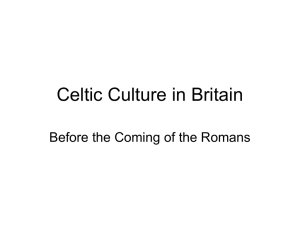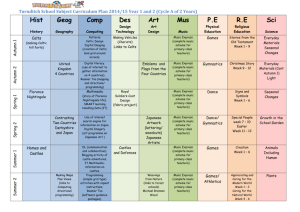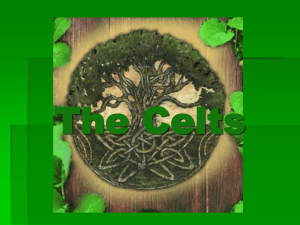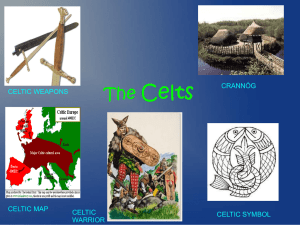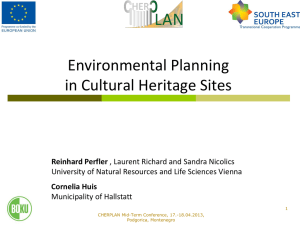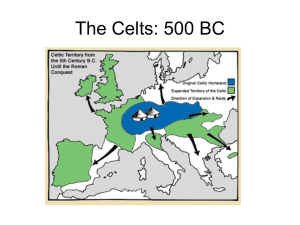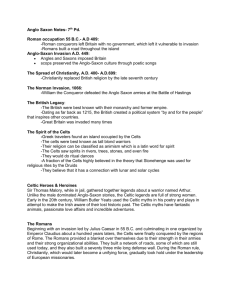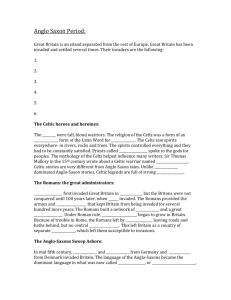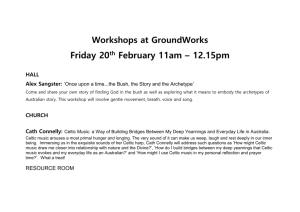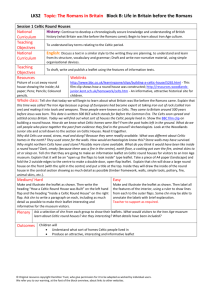Halstatt Paper
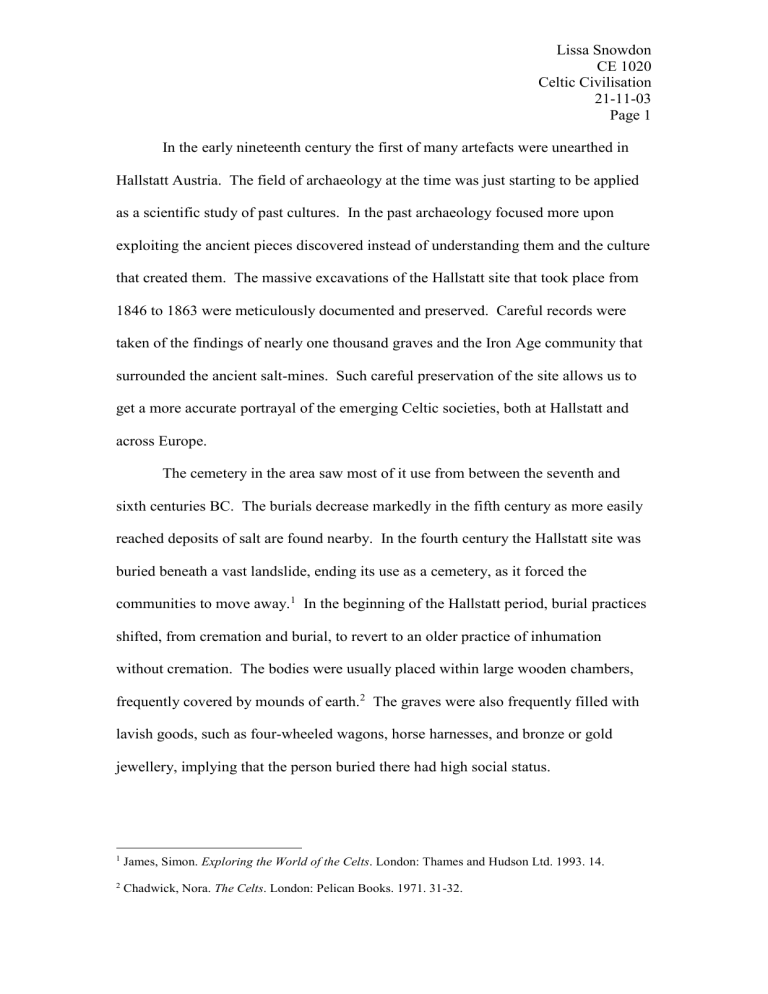
Lissa Snowdon
CE 1020
Celtic Civilisation
21-11-03
Page 1
In the early nineteenth century the first of many artefacts were unearthed in
Hallstatt Austria. The field of archaeology at the time was just starting to be applied as a scientific study of past cultures. In the past archaeology focused more upon exploiting the ancient pieces discovered instead of understanding them and the culture that created them. The massive excavations of the Hallstatt site that took place from
1846 to 1863 were meticulously documented and preserved. Careful records were taken of the findings of nearly one thousand graves and the Iron Age community that surrounded the ancient salt-mines. Such careful preservation of the site allows us to get a more accurate portrayal of the emerging Celtic societies, both at Hallstatt and across Europe.
The cemetery in the area saw most of it use from between the seventh and sixth centuries BC. The burials decrease markedly in the fifth century as more easily reached deposits of salt are found nearby. In the fourth century the Hallstatt site was buried beneath a vast landslide, ending its use as a cemetery, as it forced the communities to move away.
1
In the beginning of the Hallstatt period, burial practices shifted, from cremation and burial, to revert to an older practice of inhumation without cremation. The bodies were usually placed within large wooden chambers, frequently covered by mounds of earth.
2
The graves were also frequently filled with lavish goods, such as four-wheeled wagons, horse harnesses, and bronze or gold jewellery, implying that the person buried there had high social status.
1 James, Simon. Exploring the World of the Celts . London: Thames and Hudson Ltd. 1993. 14.
2 Chadwick, Nora. The Celts . London: Pelican Books. 1971. 31-32.
Lissa Snowdon
CE 1020
Celtic Civilisation
21-11-03
Page 2
These grave goods also provide some insight into the Hallstatt culture. Some of the graves found are of women, like the ‘princess’ of Vix, which with the great wealth of goods found buried with her suggests that women had equal status to men, at least in some cases. The presence of such archaeological evidence supports later reports by classical writers of female leaders such as Boudicca. This is a distinction from Greek culture, in which women had much less status than men. The presence of swords, shields, helmets and other war-gear in some graves implies that the warriors were given high status within the culture. Smiths as well were greatly revered for their ability to create the weapons and tools required for the survival of the society, as well as the jewellery and other items. Ore pieces, metal ingots, and the tools of metalworking (crucibles, moulds, and grindstones) were found in some individual graves, most likely of the smith himself.
3
The grave goods also provide insight into the trade relations of the Hallstatt societies. Imported goods from Greece are commonly found in burial sites, usually pertaining to wine drinking. Some examples are the giant krater found at the site in
Vix, and wine jars known as amphorae, most likely traded in Massalia, which are scattered across the south of Gaul. Greek-made pottery cups and mixing bowls for wine were also traded to the Celts, along with bronze flagons.
4
Return trade from the Celts to Greek merchants was usually in the form of raw materials. Copper, tin, and bronze were all metals commonly used for trade by the
Celtic peoples. Salt and salted foodstuffs were important for trade, leading to an
3 Harding, A. F. European Societies in the Bronze Age.
Edinburgh: Cambridge University Press. 2000.
239.
4 Chadwick, 35-36.
Lissa Snowdon
CE 1020
Celtic Civilisation
21-11-03
Page 3 increase in mining and salt-extraction at the height of the Hallstatt culture.
5
Slaves were likely trade commodities as well, although it is difficult to be certain. Grain and farm animals were probably traded as well, when surpluses allowed for it. The
Hallstatt chieftains gained and kept their power by controlling trading routes and acting as trade-intermediaries for more distant tribes.
Hillforts are a physical representation of a chieftain’s power. These were fortified settlements placed strategically upon the crests of hills. These settlements were centers of trade and manufacturing and were ruled over by a chieftain and defended by his warriors. Some of the most lavish burials are found around hillforts, implying that the cheiftains has more power than ever before. These were centers of trade, and some are built in a style similar to Greek forts, suggesting the trade of ideas as well as goods. There is a fair amount of archaeological evidence that supports the idea that these cheiftains ruled for short times and that power was frequently switching hands. There are vast amounts of weapons like swords found at hillforts, either for defenders or attackers it lays silent claim of times of instability. There is also archaeological evidence that these sites were frequently burned.
6
The fact that there were so many warriors and an extremely wealthy upper class proclaims the Celts successes as farmers. The striation of the society is only possible if everyone does not have to grow his or her own food. There were frequently farm sites in the area surrounding hillforts, others were spread out across
5 Chadwick, 36.
6 Chadwick, 37.
Lissa Snowdon
CE 1020
Celtic Civilisation
21-11-03
Page 4 the countryside, usually each were very small though, perhaps only for a single family and it’s kin.
The remains of ancient grain stores and animal remains provide the archaeological evidence of what was grown and raised within these small farming communities. Cattle, sheep, pigs and goats were all common animals seen on farms.
In areas of eastern Germany more than fifty percent of the bones found in some sites belong to cattle, implying that they formed a large significance within the local economy.
7
In general cattle remains form the majority of the animal remains, usually followed by sheep and goats, and then pigs. Bronze Age economies in general, across temperate Europe, were largely dependent upon cattle.
8
All farm animals were exploited to the best of their ability. Cattle were most likely used as a source of both meat and dairy. Goats were very useful as they provided many things, meat, milk, wool, skin, and horn. Across Mediterranean Europe they were the dominant animal resource.
Many grains were commonly planted in Celtic fields, although the majority is of ancient varieties of wheat, barley, and millet. Other plants were grown and used as a food source as well, including peas, beans, lentils, wild fruits and berries.
9
Nuts were also gathered from the forests, including acorn, hazel, and beech. The fields themselves can be located archaeologically without too much difficulty. Thornbrakes and other hedge plants frequently surrounded the fields in order to deter the
7 Harding, 140-141.
8 Harding, 143.
9 Harding, 149-150.
Lissa Snowdon
CE 1020
Celtic Civilisation
21-11-03
Page 5 wildlife from eating the growing field bare. Some of them had ditches dug around them as well, for much the same purpose.
In conclusion, there is much that can be learned about the Hallstatt culture by examining what archaeological remains were left behind. Living styles and some practices are easily passed along with the bones, scraps of metal, and other artefacts that remain with us today. Yet much of the culture and society is lost through this method. Religious rituals can only be hinted at in the treatment of the dead bodies and its subsequent burial. Much of what would have comprised the every day life of these Celtic people is lost forever, never to be truly understood.
Lissa Snowdon
CE 1020
Celtic Civilisation
21-11-03
Page 6
Bibliography
Chapman, Malcolm. The Celts: The Construction of a Myth.
London: St. Martin’s
Press Inc. 1992.
Chadwick, Nora. The Celts.
London: Pelican Books. 1971.
James, Simon. Exploring the World of the Celts . London: Thames and Hudson Ltd.
1993.
Harding, A. F. European Societies in the Bronze Age.
Edinburgh: Cambridge
University Press. 2000.
